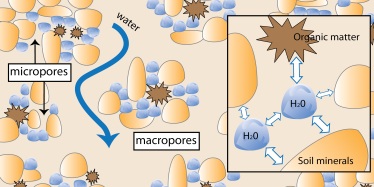Soil water

Water supply through soils is vital for both plants and soil organisms—they need water to survive.
Soil water contains nutrients that move into the plant roots when plants take in water.
Water enters the soil through large pores (macropores) and is stored in many small pores (micropores). Porous soils have a balance between macro and micro pores.
In Queensland
Queensland has highly variable rainfall and agricultural lands can experience extremes of wet and dry.
When conditions are predominantly dry, there can be insufficient moisture in the soil to grow crops or maintain pastures.
On the other hand, sometimes excess water can be a problem too.
Specific terms
To understand how much water is held in soil, the following terms are important:
- field capacity—the amount of water held in the soil after it has been fully wetted and free drainage has stopped. Water applied above this limit will make the soil saturated but water will drain quickly or be lost as runoff.
- permanent wilting point—the soil moisture condition at which the plant could not obtain water and has wilted and died. The crop cannot be revived by an irrigation or rainfall event.
- plant available water capacity (PAWC)—the amount of water between field capacity and permanent wilting point that is available to a plant. This requires careful management and depends on soil texture, structure and organic matter in the soil.
Controlling water use
When soil is at field capacity, further rainfall cannot be stored in the soil profile so most of the water runs off and can cause erosion.
When a soil profile is full, one option is to plant a crop to use the water. This opportunity cropping reduces the stored water and makes room for more from further rainfall.
When managing soil water, the following should be considered:
- organic material increases the soils capacity to store water
- knowing the depth of rooting in plants is important—for example shallow rooted plants are unlikely to get access to water in soils where there are large stores in the subsoil
- accurate estimates of soil water allow for a closer match between nutrient supply and irrigation scheduling.
Waterlogging
When the soil is at or near field capacity, micropores in the soil are full of water and the macropores allow for the movement of oxygen.
When a soil is above field capacity, the macropores fill with water and the soil is depleted of oxygen. When this happens, plant roots cannot get oxygen from the soil and microbial activity slows. Over a prolonged period, plants eventually die.
Also, without oxygen in the soil, nitrogen breaks down and is lost as gas in a process called denitrification. This can cause a decline in soil fertility.
Soil limitations to water entry
Water infiltration into the soil will be limited by the least permeable layer, so restrictions near the surface may be more important than restrictions deep in the profile.
If water is unable to enter the soil profile due to surface sealing or hardsetting for example, the ability of the soil to store water is reduced.
Surface seal
A surface seal or crust is a thin layer (1−10mm) formed on the soil surface by water drop impact. It can have a porosity 90% lower than that of an unsealed soil. Permeability declines during rain or irrigation when the surface aggregates break down and are compacted under drop impact.
Surface sealing is largely responsible for restricted initial infiltration under rainfall or irrigation. Water that is unable to move into the soil profile will run off.
Sealing and crusting may be natural, or induced when soil cover is removed. It is sometimes associated with sodicity.
Hardsetting layer
Hardsetting is an inherent feature of some soils (for example some texture-contrast soils and weakly structured cracking clays).
Soil aggregates break down during wetting, then set to a hard, structureless mass during drying. This can be exacerbated by over-cultivation and reduction in organic matter, which reduces aggregate stability.
Soil compaction
Surface compaction is induced by tillage tool smearing, tractor wheels and farm animals.
This occurs when the soil is sheared or compressed at the critical moisture content known as the plastic limit.
Compaction results in high soil strength and reduced porosity, preventing water from accessing the root zone. In tilled soils, a plough pan can be created directly under the tilled layer by the smearing action of tines.
Compaction below the tilled layer (subsurface compaction) is created by high axle loads under moist soil conditions. Water is unable to move freely through the soil profile. In dry conditions, subsurface compaction will prevent roots accessing deep stored moisture.
Impermeable subsoils
Impermeable subsoils are an inherent feature of some soils and may be associated with a sodic subsoil or shallow soil profile on rock.
Water entry is limited and under high rainfall, waterlogging may occur on top of the impermeable layer.
Identifying restrictive soil layers
A layer that restricts water infiltration in the soil may have the following characteristics:
- The soil is not wet enough after good rain.
- The soil surface appears sealed after rain.
- Water runs off rather than infiltrating.
- Waterlogging is a problem.
What can I do?
Management practices that can help overcome restrictive soil layers include:
- maintaining stubble cover
- gypsum application
- cultivation
- pasture phase
- minimising traffic
- controlled traffic farming practices
- rotation with deep-rooting crops.
Each of these management practices will improve infiltration in only one or two of the restrictive layers.
Since the most restrictive layer will control water movement, simply removing one may not improve the overall physical condition of the soil profile. A combination of practices may be required to achieve real benefits.


